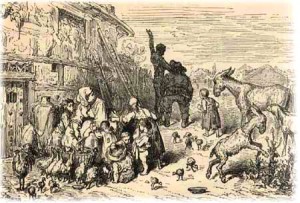Sancho Panza portends the role of a literary Everyman—
[2col1]On first impression, Sancho Panza portends the role of a literary Everyman, a symbol, perhaps, of the common man himself, of a Spanish rustic- uneducated, illiterate, and hopelessly poor with a simple personality and an even more simplistic view of life.
Indeed, he is often verbose, outspoken- speaking with the greatest certainty of things he knows nothing about, citing refranes that sometimes do not even seem to fit the circumstance, and yet, he cites them anyway. His own description tells us that his origins are humble. In fact, Sancho describes himself as poor villano. He is the common man with limited resources and more often than not, must make his way through life by his own wits.
More than once, Sancho Panza underscores his claim to status, telling us that he is a cristiano viejo. By that, of course, he does not reference his age in life, but rather his position before God as a genuine Spaniard- he is a cristiano viejo: his lineage is pure Caucasian without admixture of either Moorish or Jewish blood. Like any royal family whose bloodline must be pure, Sancho Panza offers the same commendation of his own heritage. He is poor, but he is royal stock in that he is a true Christian and a true Spaniard.
Unlike Don Quixote, whose physical features and stature are carefully described by Cervantes, Sancho Panza is never really depicted, at least in any appreciable detail. Indeed, it would seem that Cervantes deliberately ignores him, leaving the reader to garner any detail about the personality or physical features of Sancho Panza on his own. The name, Panza, of course, is probably a word play as well as a comic description. He is Panza, because his waistline is a bit of a paunch (or belly). Don Quixote may be thin and tall, but Sancho Panza, is short and round, with a body closer to the shape of a melon than anything else.
There is, of course, the intriguing description in chapter 9 based on an Arabic writer whom Cervantes names Cide Hamete Benengeli. After having given a number of details, Cervantes next immediately cautions that the Benengeli may not be reliable after all-
Otras algunas menudencias había que advertir, pero todas son de poca importancia y que no hacen al caso a la verdadera relación de la historia; que ninguna es mala como sea verdadera. Si a ésta se le puede poner alguna objeción cerca de su verdad, no podrá ser otra sino haber sido su autor arábigo, siendo muy propio de los de aquella nación ser mentirosos; aunque, por ser tan nuestros enemigos, antes se puede entender haber quedado falto en ella que demasiado.
So, if Arabic propensity is toward both untruth and understatement, we really don’t know to think of Sancho Panza’s depiction in the supposed Arabic manuscript- la barriga grande, el talle corto y las zancas largas; y por esto se le debió de poner nombre de Panza y de Zancas. All this leaves us confused. We know he is called Panza because he has a large barriga, but given the Arabic tendency for understatement, would this mean that the large barriga is much larger than what is actually said?[endcol]
[2col2]When we read the entire story of Don Quixote, however, we discover that Cervantes does tell us a great deal about the character and personality of Sancho Panza. In fact, the suggestion that Cervantes seemingly shortchanges or ignores Sancho Panza is itself a literary illusion.
For the simplistic reader, of course, Sancho Panza may seem simple, may seem predictable, but for the more profound and reflective reader, Sancho Panza emerges as having a very complex personality and an unwavering sense of devotion and loyalty. He may be poor, but his character is grand. There is no doubt: Sancho Panza is, as he claims, a cristiano viejo.
Consider for a moment book two in Don Quixote. In chapter XLV, the rustic character of Sancho Panza easily eclipses the crass manners of a Duke and a supposed noble and chivalric court. Indeed, Sancho Panza emerges as a noble character fully capable of governing the mock island Barataria (or island of Come-cheaply) entrusted to him by the Duke. The Duke, of course, had meant to embarrass the rustic peasant, promoting him as ruler in order to entertain himself and his court. For the Duke it was all a game meant to relieve the empty boredom of a monotonous court life. Sancho, however, accepts the role with child-like simplicity, but governs with inexplicable wisdom, deciding even the most complex of legal cases with one stroke. The ease at which he reaches a decision astonishingly reminds us of the biblical Solomon.
Sancho’s competency, of course, confounds the Duke, and ultimately reverses any semblance of play-acting with the Duke himself becoming the comic figure. That, of course, was not Sancho’s intention. He is, as he describes himself, an hombre pacifico. Actually, Sancho Panza is not the kind of man who would knowingly hurt or embarrass anyone, not even a crass Duke.
In that respect, I suppose, he is like the Caballero of La Mancha himself. Sancho Panzo may be a lowly peasant, a hopeful escudero to the hopeful knight-errant, Don Quixote, but from the perspective of Cervantes, both figures are true caballeros, true caballeros indeed.
And here it is where we, as readers, come in contact with the literary genius of Cervantes. We think we are reading a shallow comedy meant merely to entertain us when in truth we are reading a story which touches our soul, a story which seeks to make us all into better caballeros- worthy of the noble Don Quixote, and equally worthy of the noble and lowly Sancho Panza. Unamuno, of course, makes a similar point in describing the two figures as emblematic of faith itself, bestowing on them an almost biblical stature.[endcol]

